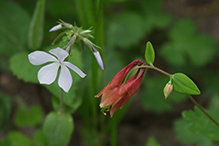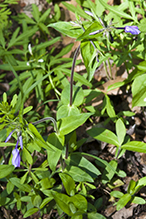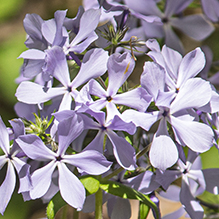wild blue phlox
(Phlox divaricata ssp. laphamii)
Conservation • Wetland • Description • Habitat • Ecology • Use • Distribution • Taxonomy
Description |
Wild blue phlox is a 9″ to 18″ tall, erect, perennial forb that rises on fertile and nonfertile shoots from a taproot and above-ground stolons. Nonfertile stems recline on the ground with their tips ascending (decumbent). Fertile stems are erect, leafy, unbranched except near the inflorescence, green to reddish brown. Both types of stems are covered with long, fine, soft, white hairs. Nonfertile stems are shorter and less hairy than fertile stems. The leaves are opposite, stalkless, and 1″ to 2¼″ long, ⅜″ to 1″ wide. Leaves on nonfertile stems are narrowly egg-shaped to lance-shaped. They taper to a blunt or rounded tip. Leaves on fertile stems are lance-shaped and taper to a pointed tip but rarely to a sharp pointed tip. The margins of all of the leaves are untoothed. The lower leaves are almost hairless. The upper leaves are hairy. The inflorescence is a loosely branched cluster of 9 to 30 flowers at the end of the flowering stem. It is covered with fine, glandular hairs. The flowers are ¾″ to 1″ wide and fragrant. They have 5 pale blue-purple to red-purple or sometimes white petals. The petals unite at the base forming a long, thin corolla tube, then separate into 5 long, widely spreading lobes. The petal lobes are inversely egg-shaped. They abruptly narrow before the throat becoming much narrower toward the flower center than at their tips. The tips are rounded and may be slightly indented or slightly pointed but are not notched. The stamens are not visible at the opening of the corolla tube. The fruit is a 3-chambered, egg-shaped capsule with usually 1, rarely 2, seeds per chamber. |
Height |
9″ to 18″ |
Flower Color |
Pale blue-purple to red-purple or white |
Similar Species |
Downy phlox (Phlox pilosa ssp. fulgida), has much narrower leaves that narrow to a sharp, hardened tip. The petal lobes taper gradually to the throat. The stamens are visible at the opening of the corolla tube. Wild sweet William (Phlox maculata) has an unbranched, cylinder-shaped inflorescence. The stamens are visible at the opening of the corolla tube. Garden phlox (Phlox paniculata) is a tall, cultivated plant that can get to six feet tall. The stamens are visible at the opening of the corolla tube. Moss phlox (Phlox subulata ssp. subulata) is a prostrate ground cover with whorled, linear to awl-shaped leaves. The flower petals are notched at the tip. It is found in rocky areas and sandy or gravelly soil. Dame’s rocket (Hesperis matronalis) is much taller, has alternate, toothed leaves, and has flowers with four petals. |
Habitat |
Moist soils. Rich, moist, deciduous woods; fields. |
Ecology |
Flowering |
April to June |
Pests and Diseases |
|
Use |
|
Distribution |
||
|
Sources |
|
| 7/14/2023 | ||
Nativity |
||
Native |
||
Occurrence |
||
|
||
Taxonomy |
|
Kingdom |
|
Division |
Tracheophyta (Vascular Plants) |
Subdivision |
Spermatophytina (Seed Plants) |
Class |
|
Order |
Ericales (heathers, balsams, primroses, and allies) |
Family |
Polemoniaceae (phlox) |
Subfamily |
Polemonioideae |
Genus |
Phlox (phloxes) |
Section |
Divaricatae |
Species |
Phlox divaricata (blue phlox) |
Subordinate Taxa |
|
Synonyms |
|
| Phlox divaricata var. laphamii | |
Common Names |
|
blue phlox forest phlox Lapham’s phlox sweet William wild blue phlox wild sweet-William woodland phlox |
|
Glossary
Corolla
A collective name for all of the petals of a flower.
Decumbent
Reclining on the ground but with the tips ascending.
Glandular hairs
Hairs spread over aerial vegetation that secrete essential oils. The oils act to protect against herbivores and pathogens or, when on a flower part, attract pollinators. The hairs have a sticky or oily feel.
Stolon
An above-ground, creeping stem that grows along the ground and produces roots and sometimes new plants at its nodes. A runner.
Visitor Photos |
||
Share your photo of this plant. |
||
This button not working for you? |
||
Wayne Rasmussen |
||
 |
 |
|
Wild columbine and wild blue phlox |
||
 |
||
MinnesotaSeasons.com Photos |
||
 |
 |
|
Plant |
Plant |
|
 |
 |
|
Plant |
Inflorescence |
|
 |
 |
|
Inflorescence |
Flowers |
|
 |
||
Flowers |
|

Slideshows |
|

Visitor Videos |
||
Share your video of this plant. |
||
This button not working for you? |
||
|
Other Videos |
||
Phlox divaricata (Wild Blue Phlox) |
About
Uploaded on Apr 27, 2010 http://www.prairiemoon.com/ - This native Phlox is great for the woodland or a sunny location. Observe it blooming here in the Prairie Moon gardens April 21. |
Wild Blue Phlox (Phlox divaricata) |
About
Published on Apr 17, 2012 Wild Blue Phlox (Phlox divaricata) |
White Oak Sink - Blue Phlox |
About
Uploaded on Jan 26, 2011 A glimpse at one area of the incomparable White Oak Sink and its forest floor, carpeted with Blue Phlox and May-apple. Date taken: April 21, 2010. |

Visitor Sightings |
||
Report a sighting of this plant. |
||
This button not working for you? |
||
| Wayne Rasmussen 5/19/2018 |
Location: Rice Lake State Park Wild columbine and wild blue phlox |
 |
| Wayne Rasmussen 6/1/2016 |
Location: Rice Lake SP, Steele Co, MN |
 |
| Wayne Rasmussen 5/31/2016 |
Location: Nerstrand Big Woods State Park |
 |
MinnesotaSeasons.com Sightings |
||

|
Created: 5/10/2005 Last Updated: © MinnesotaSeasons.com. All rights reserved. |
